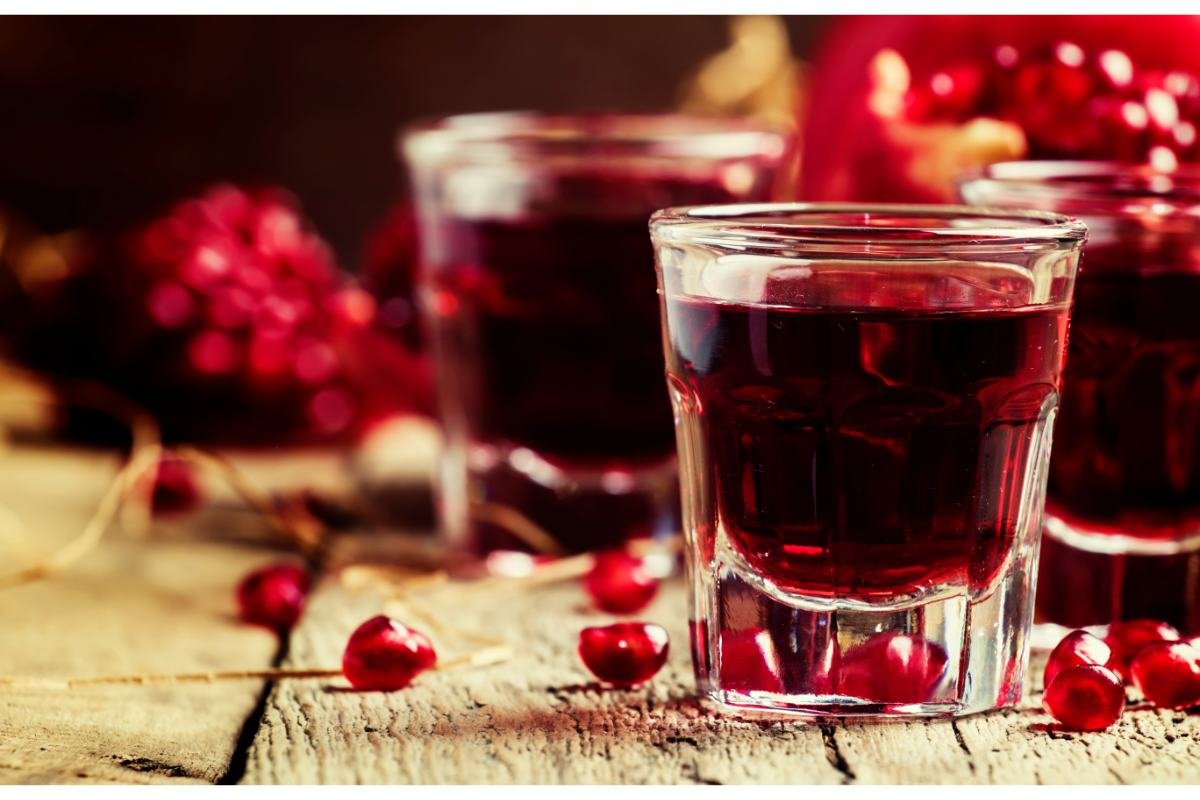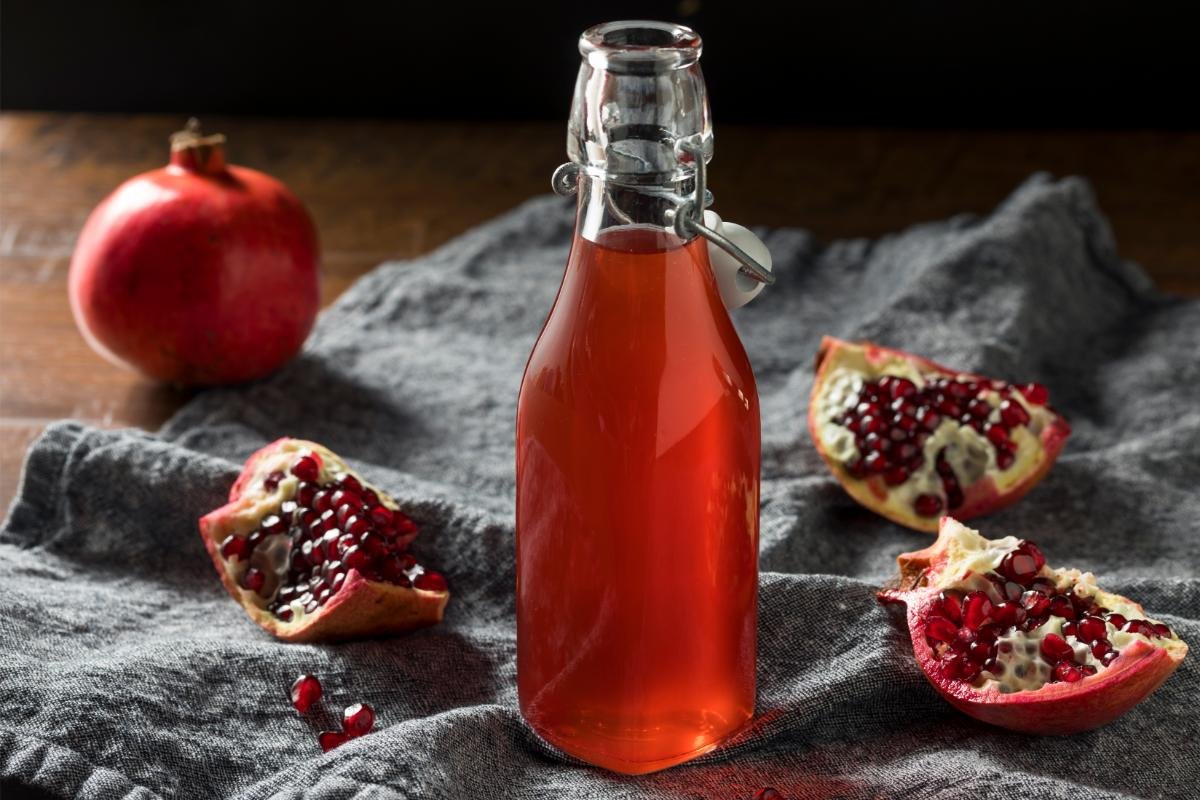Grenadine has a storied past, winding its way through the annals of mixology and gastronomy with a vibrant hue and a sweet, tart flavor that captures the essence of pomegranate. This syrup, traditionally made from pomegranate juice, sugar, and water, has adorned cocktails and dishes with its ruby-red splendor, adding depth and complexity to every creation it touches. Its journey from a simple fruit syrup to a staple of bars and kitchens worldwide is a testament to its versatility and enduring appeal.
The significance of grenadine extends beyond its taste and color; it represents a bridge between the culinary arts and mixology, marrying flavors in both classic and innovative ways. The evolution of grenadine from a basic cocktail ingredient to a gourmet kitchen staple reflects a broader trend towards artisanal and homemade food products, emphasizing quality and flavor over convenience and cost.
In this blog, we will explore everything there is to know about grenadine: its history, how to make it at home, variations to the classic recipe, its role in mixology, culinary applications, and tips for preservation and storage. Whether you’re a seasoned mixologist, a culinary enthusiast, or simply curious, this comprehensive guide will illuminate the art of making grenadine, encouraging you to explore its potential and integrate it into your repertoire.
Understanding Grenadine

What is Grenadine?
At its core, grenadine is a sweet, red syrup traditionally made from pomegranate juice, sugar, and sometimes lemon juice or citric acid. Its name is derived from the French word “grenade,” meaning pomegranate, reflecting its original composition. However, the grenadine found on supermarket shelves often strays from its authentic roots, relying on artificial flavors, colors, and high-fructose corn syrup, a far cry from the rich, nuanced flavor of the real deal.
Common Misconceptions
One of the biggest misconceptions about grenadine is that it is cherry-flavored. This confusion likely stems from the similar appearance and consistency of cherry syrup and commercial grenadine, which sometimes uses cherry juice as a cheaper alternative to pomegranate. However, authentic grenadine is pomegranate-based, offering a unique flavor profile distinct from cherry.
Another common misconception is that grenadine is merely a sweetener. While it does add sweetness to cocktails and dishes, its role is more complex, contributing tartness, color, and depth of flavor that enhances the overall experience.
The Importance of Homemade vs. Store-Bought
The debate between homemade and store-bought grenadine boils down to control and quality. Homemade grenadine allows for customization of sweetness, flavor intensity, and ingredient quality, offering a fresher, more authentic taste. Moreover, making grenadine at home sidesteps unnecessary additives and preservatives found in commercial products, ensuring a cleaner, healthier syrup.
The resurgence of interest in homemade grenadine within both the mixology and culinary worlds underscores a broader appreciation for craftsmanship and authenticity. By taking the time to create grenadine from scratch, individuals can reconnect with the traditional roots of this versatile syrup, exploring its full potential in a way that store-bought versions simply cannot match.
As we delve into the specifics of making grenadine, remember that the process is as rewarding as it is educational, providing insight into the art of syrup-making and the endless possibilities it presents.
The Basic Recipe

Creating your own grenadine is a simple yet rewarding process that invites experimentation and customization. Here’s how to craft a classic grenadine at home, with guidance to ensure success on your first try.
Gather Your Ingredients
Start with the basics:
- Pomegranate Juice: 2 cups (freshly squeezed for the best flavor, though high-quality bottled juice without added sugar or preservatives is a suitable alternative)
- Sugar: 1 cup (granulated white sugar for a neutral sweetness; adjust to taste)
- Lemon Juice: 1 tablespoon (freshly squeezed to balance the sweetness and add a subtle tartness)
Step-by-Step Instructions
- Combine Pomegranate Juice and Sugar: In a medium saucepan, mix the pomegranate juice and sugar. Stirring constantly, cook over medium heat until the sugar completely dissolves. This process ensures a smooth syrup without any grainy texture.
- Simmer: Once the sugar dissolves, reduce the heat to low and let the mixture simmer gently. You want to thicken the syrup slightly without boiling it vigorously, as too high a heat can break down the flavors and alter the color. This step should take about 10 to 15 minutes.
- Add Lemon Juice: After the mixture has thickened to your liking, remove the saucepan from the heat and stir in the lemon juice. The acidity from the lemon juice not only balances the sweetness but also acts as a preservative, extending the shelf life of your grenadine.
- Cool and Bottle: Allow the syrup to cool to room temperature. Then, using a funnel, pour the grenadine into a clean, airtight glass bottle. Proper storage is key to maintaining the freshness and vibrant color of your homemade syrup.
- Refrigerate: Store your grenadine in the refrigerator. Chilling not only preserves the syrup but also enhances its rich, refreshing taste.
Tips for First-Timers
- Quality Matters: The quality of your pomegranate juice will significantly impact the flavor of your grenadine. Opt for the freshest juice possible, and consider juicing pomegranates yourself if they’re in season.
- Adjust to Taste: Feel free to adjust the amount of sugar based on how sweet you want your grenadine to be. Remember, you can always add more, but you can’t take it away once it’s dissolved.
- Experiment with Texture: For a thicker syrup, simmer the mixture for a longer period. Just keep an eye on it to prevent over-reduction, which can lead to a too-thick consistency that won’t pour well.
- Label Your Creation: Don’t forget to label your bottle with the date you made the grenadine. Homemade grenadine typically lasts up to a month in the refrigerator, but it’s always best to note when you made it for quality assurance.
Making your own grenadine not only allows for customization but also connects you to the authentic flavors and traditions of mixology and culinary arts. As we move forward, we’ll explore how to further customize your grenadine, adding unique flavors and personal touches to this classic syrup.
Advanced Variations
Once you’ve mastered the basic grenadine recipe, it’s time to experiment with flavors that can elevate your cocktails and culinary creations. These advanced variations invite you to infuse your grenadine with additional layers of taste, making each batch uniquely yours.
Incorporating Different Flavors
Expanding the flavor profile of your grenadine opens up a world of possibilities. Here’s how to infuse it with additional tastes:
- Vanilla Infusion: Add a vanilla pod, split and scraped, to the saucepan along with the pomegranate juice and sugar. Simmer as usual. The vanilla adds a rich, aromatic dimension that pairs wonderfully with the tartness of the pomegranate.
- Orange Blossom or Rose Water: After removing the saucepan from the heat, stir in a teaspoon of orange blossom or rose water. These floral notes introduce a subtle elegance, enhancing the grenadine’s complexity.
- Herbal Touches: Simmer fresh herbs, such as thyme or rosemary, with the pomegranate juice and sugar. Strain the herbs out before bottling. This method infuses a fresh, botanical character into your syrup, perfect for craft cocktails.
Adjusting Sweetness and Thickness
Personalizing your grenadine also means finding the perfect balance of sweetness and consistency for your taste:
- Customize Sweetness: Start with less sugar than the recipe calls for, and taste as you go. Remember, it’s easier to add more sugar during the cooking process than to correct an overly sweet syrup.
- Fine-tune Thickness: Control the syrup’s thickness by adjusting the simmering time. Less time results in a thinner syrup, while more time yields a thicker consistency. Keep in mind the syrup will thicken slightly as it cools.
Non-alcoholic and Alcoholic Versions
For an adult twist or a non-alcoholic option that everyone can enjoy, consider these adaptations:
- Alcoholic Grenadine: Enhance your grenadine by adding a splash of high-quality spirits such as vodka or rum. Incorporate the alcohol after removing the syrup from the heat, ensuring the alcohol doesn’t evaporate. This version adds a kick to cocktails and adult beverages.
- Non-alcoholic Flavor Boost: For a non-alcoholic but equally adventurous variation, add fruit extracts or non-alcoholic spirits to your cooled grenadine. These can introduce complex flavors without the need for alcohol, keeping the syrup versatile for all audiences.
Creative Combinations
Don’t be afraid to mix and match flavors. Combine vanilla infusion with orange blossom water for a grenadine that’s rich yet floral, or blend herbal touches with fruit extracts for a truly unique concoction. The key is to start with small amounts, tasting and adjusting as you go.
Experiment and Enjoy
Creating advanced variations of grenadine is as much about the journey as it is about the destination. Each batch is an opportunity to explore new flavors and techniques, refining your preferences and discovering new favorites along the way. Whether you’re crafting cocktails, enhancing desserts, or experimenting with savory applications, these customized grenadines add a personal touch that can’t be replicated with store-bought versions.
As you become more comfortable with these advanced techniques, continue to push the boundaries of flavor and creativity. The versatility of grenadine means there are always new combinations to try and favorites to discover, making it an endlessly rewarding addition to your culinary and mixology toolkit.
Usage in Mixology
Grenadine’s vibrant color and sweet-tart flavor make it a beloved ingredient in the world of mixology. Whether you’re stirring up classic cocktails or inventing modern concoctions, homemade grenadine can elevate your drinks from good to unforgettable. Let’s explore how to incorporate grenadine into your mixology repertoire.
Classic Cocktails with Grenadine
Homemade grenadine shines in classic cocktails, where its depth of flavor and natural sweetness play a pivotal role. Here are a few traditional drinks that benefit from the authentic taste of homemade grenadine:
- Tequila Sunrise: Pour grenadine over a mixture of tequila and orange juice, allowing it to settle at the bottom for a sunrise effect. The quality of your grenadine makes all the difference in this visually stunning cocktail.
- Shirley Temple: Mix grenadine with ginger ale or soda water and garnish with a cherry for a non-alcoholic drink that delights with its simplicity and sweetness. Homemade grenadine transforms this childhood favorite into a sophisticated beverage.
- Sea Breeze: Add a splash of grenadine to vodka, cranberry juice, and grapefruit juice for a refreshing and colorful twist on this classic cocktail. The grenadine enhances the drink’s fruity flavors while contributing a beautiful gradient of color.
Modern Twists and Creations
Grenadine’s versatility also inspires contemporary mixologists to craft innovative drinks. Experiment with these ideas to create your signature cocktails:
- Spicy Grenadine Margarita: Combine your grenadine with tequila, lime juice, and a dash of hot sauce or a slice of jalapeño for a cocktail that balances sweet, tart, and spicy flavors.
- Grenadine and Herb Spritz: Use your herbal-infused grenadine in a spritz with white wine, sparkling water, and a sprig of rosemary or thyme. This drink offers a refreshing herbal note that’s perfect for summer evenings.
- Craft Sodas: For a non-alcoholic option, mix grenadine with sparkling water and a squeeze of lime for a homemade soda. Add a few drops of bitters for complexity, creating a sophisticated soft drink that’s both refreshing and flavorful.
Balancing Flavors
Achieving the perfect balance of flavors is key to successful cocktail making. Here are some tips for using grenadine to its full potential:
- Start Small: Grenadine is potent, so begin with a small amount and adjust to taste. It’s easier to add more than to dilute a drink that’s become too sweet.
- Consider Acidity: Grenadine adds sweetness, so balance it with acidic components like citrus juice. This balance is crucial for creating a harmonious drink.
- Complement with Bitters: A dash of bitters can counteract the sweetness of grenadine, adding depth and complexity to your cocktails.
Embrace Creativity
Mixology is an art form that encourages creativity and experimentation. Homemade grenadine not only elevates the flavor profile of your cocktails but also invites you to explore and innovate. By starting with quality ingredients and adjusting to taste, you can craft drinks that showcase your personal style and the nuanced flavors of your homemade syrup.
Culinary Applications
Grenadine’s appeal extends far beyond the bar, offering a sweet and tart flavor profile that can enhance a wide range of dishes. From desserts to savory plates, the versatility of this pomegranate syrup allows for creative and delicious culinary explorations. Let’s dive into the ways grenadine can be integrated into your cooking.
Desserts and Confections
Grenadine’s rich color and complex flavor make it an excellent addition to desserts, providing a unique sweetness and a touch of acidity that can elevate simple recipes into something special.
- Pomegranate Glaze for Cakes: Mix grenadine with powdered sugar to create a vibrant glaze perfect for drizzling over cakes, muffins, or scones. The syrup adds moisture and a burst of flavor to baked goods.
- Grenadine Fruit Salad: Toss a variety of fresh fruits with a splash of grenadine for a refreshing salad. The syrup acts as a dressing, enhancing the natural sweetness of the fruit and adding a beautiful sheen.
- Homemade Ice Cream and Sorbets: Incorporate grenadine into your ice cream or sorbet base for a fruity twist. Its concentrated flavor adds depth to frozen treats, with the bonus of a stunning natural color.
Savory Dishes
Grenadine may be known for its sweetness, but its acidity can also complement savory dishes, adding an unexpected and delightful layer of flavor.
- Grenadine-Infused Marinades: Add grenadine to marinades for chicken or pork to introduce a subtle sweetness and aid in caramelization during cooking. The sugar content helps create a beautiful sear and a complex flavor profile.
- Salad Dressings: Whisk grenadine with olive oil, vinegar, and a pinch of salt to create a fruity salad dressing. It’s particularly good in salads that feature nuts, cheeses, or robust greens like arugula or kale.
- Glazes for Roasted Vegetables: Brush vegetables with a grenadine glaze before roasting. The natural sugars caramelize in the oven, enhancing the vegetables’ sweetness and adding a hint of tartness.
Creative Garnishes and Presentations
Utilizing grenadine’s striking color and flavor can add an artistic touch to your plates, making them visually appealing and flavorful.
- Decorative Plate Drizzles: Use grenadine to add color and flavor to dessert plates. A drizzle around the edge or beneath a dessert can elevate the presentation significantly.
- Cocktail-Inspired Desserts: Create desserts that mimic the flavors of classic grenadine cocktails, such as a Tequila Sunrise cheesecake or a Shirley Temple cupcake, incorporating grenadine both in the batter and as a topping.
- Edible Flowers: Pair grenadine-glazed or -infused dishes with edible flowers for a visually stunning and gastronomically delightful presentation. The floral notes complement the pomegranate’s tartness beautifully.
Pushing Culinary Boundaries
Grenadine’s unique flavor profile encourages chefs and home cooks alike to experiment with new combinations and techniques, pushing the boundaries of traditional recipes. By integrating this versatile syrup into both sweet and savory dishes, you can discover new taste sensations and presentation ideas that captivate the palate and the eye.
Preservation and Storage
Making grenadine in bulk or simply ensuring your homemade batch lasts as long as possible requires knowledge of proper preservation and storage techniques. By following these best practices, you can extend the life of your grenadine, maintaining its freshness and flavor for future use.
Best Practices for Longevity
- Sterilize Your Containers: Before bottling your grenadine, sterilize the bottles or jars by boiling them in water for about 10 minutes. This step eliminates any bacteria or yeast that could spoil the syrup.
- Cool Before Bottling: Allow your grenadine to cool completely before transferring it to your sterilized containers. Pouring hot syrup into a cold container could cause the glass to crack, and bottling while hot could promote fermentation.
- Seal Tightly: Ensure your containers have tight-fitting lids to prevent exposure to air. Oxygen can degrade the quality of grenadine over time, leading to oxidation and loss of flavor.
Refrigeration and Shelf Life
- Refrigerate: Always store your grenadine in the refrigerator. The cold temperature slows down the degradation process, keeping your syrup fresh and vibrant.
- Consume Within One Month: Homemade grenadine, being free of preservatives, has a shorter shelf life than commercial varieties. For the best taste and quality, use your grenadine within one month of making it.
- Consider Small Batches: If you find yourself not using large quantities of grenadine, consider making smaller batches. This practice ensures that you always have fresh grenadine on hand without the risk of spoilage.
Signs of Spoilage
Being able to identify when your grenadine has gone bad is crucial to prevent the consumption of spoiled goods:
- Off Smell: If your grenadine smells sour or fermented, it’s a clear sign that it has begun to spoil and should not be consumed.
- Mold Growth: Any visible mold growth on the surface of the grenadine or inside the bottle indicates spoilage. Discard the syrup immediately if mold is present.
- Change in Texture: If the syrup becomes overly thick or develops any strange textures, it’s best to err on the side of caution and throw it out.
Maintaining Quality
Taking the time to properly preserve and store your grenadine will pay off in the long run. Not only does it ensure that you always have a high-quality syrup ready for your culinary and mixological creations, but it also respects the effort and ingredients that went into making it. By following these guidelines, you can enjoy your homemade grenadine to its fullest, exploring its versatility in a variety of drinks and dishes while maintaining the highest standards of food safety and quality.
Conclusion
Embarking on the journey of making your own grenadine opens up a world of culinary and mixological exploration, inviting you to infuse your creations with a touch of homemade excellence. Whether you’re stirring it into a classic cocktail, drizzling it over a dessert, or experimenting with savory dishes, the rich, complex flavors of homemade grenadine elevate every dish and drink it touches. By following the guidelines and tips shared in this guide, you’re well on your way to mastering the art of grenadine, ensuring each batch is as delicious as it is vibrant.
As you continue to experiment and refine your grenadine recipes, remember that the essence of great cooking and mixology lies in the joy of creation and the sharing of those creations with others. We encourage you to share your grenadine-enhanced recipes on RecipesZap, where a community of culinary enthusiasts and cocktail aficionados can find inspiration and delight in your unique contributions.
Thank you for joining us on this flavorful journey. Here’s to the many delightful concoctions that await you, each a testament to the beauty and versatility of grenadine made with love and care.

